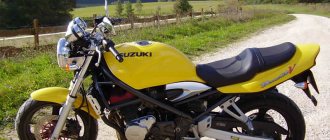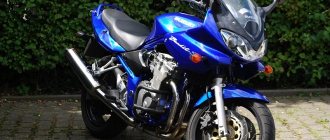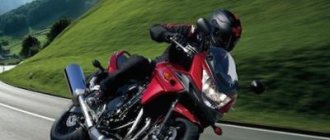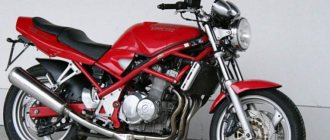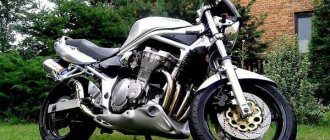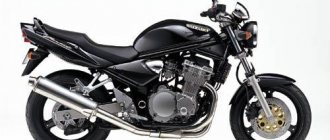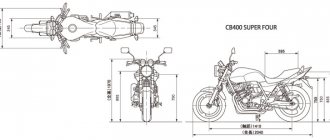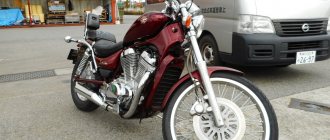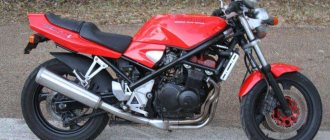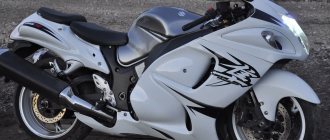The Suzuki Bandit 400 is a motorcycle equipped with a four-stroke engine that includes four cylinders. The motor is equipped with a liquid cooling system. Engine power reaches 60 hp and torque is 3.9 N.
Suzuki bandit 400 is a fairly economical vehicle, as fuel consumption is 5 - 6.5 liters. This figure directly depends on the individual driving style and the condition in which the carburetor is located.
Model overview
So what do we have? Firstly, the engine - the number 400 in the name is not just a number, it is the volume of the engine. Actually, the volume is 398 cubes, but the manufacturers decided to round it up.
The Suzuki Bandit 400 engine is a four-cylinder, four-stroke, liquid-cooled, which, you will agree, compared to many other motorcycles in the same price category with conventional air cooling, looks like a significant plus.
The engine power, at 12 thousand revolutions per minute, is 60 horses. Torque is 3.9 Newtons per meter, which, however, is not enough to tell a non-professional.
Fuel consumption is approximately 5-6.5 liters and depends on the driving style of the pilot and the technical condition of the carburetors.
The length of the motorcycle is just over two meters, with a wheelbase length of 143 centimeters.
The weight of the motorcycle (with an empty tank, of course, the volume of which, by the way, is 14 liters) is 168 kg.
Suzuki Bandit, this name has become a cult name in Europe, and primarily thanks to it - Suzuki Bandit 1200, technical specifications, and much more about the largest Bandit in our article.
Have you encountered the problem of transporting your iron friend? All the necessary information to solve this problem is here.
Disadvantages of Suzuki GSF400 Bandit
According to reviews, Suzuki Bandit has many more advantages than outright mistakes of designers. The main “cons” of the motorcycle are typical for all powerful Suzukis, but it also has its own features. If we talk about the first ones, then Suzuki GSF:
- equipped with a front suspension that is too soft for Russian roads;
- since the motorcycle is dynamic and fast, there is increased wear of parts and chassis components;
- requires highly qualified technical service;
- not clear enough, “blurry” gear shifting;
- high sensitivity to fuel quality.
Of the individual technical characteristics of the Suzuki Bandit with a minus sign, what stands out, first of all, is the inconvenience of riding when the driver is over 180 cm tall. This is explained by the primary focus on the domestic market, where the average biker is short, and not on Russian heroes. Another, less significant drawback of the Suzuki Bandit GSF is that the rear shock absorber is not protected from debris. To extend its service life, experienced owners advise installing a mudguard on the rear swingarm yourself.
Design features
“Bandit” is positioned as a city bike.
Maneuverable, lightweight, with a good engine for its weight. The basis is a thick steel frame, with a pendulum mounting unit reinforced with castings. Manufacturers did not hide the frame behind plastic, which I personally think is a very good move; the thick frame creates a feeling of reliability and power.
Nothing sticks out or sticks out, the frame fits organically into the contours of the engine (or the engine fits into the frame) and looks like one with it.
Under the fork, hidden behind the front wheel, there is a radiator that does an excellent job of cooling the engine.
It is worth saying that the motorcycle, due to its orientation towards the Japanese market, has too soft a front suspension , so a little tuning would not hurt.
It's easier with the rear suspension. The pendulum is equipped with a system for adjusting the degree of compression of the springs, so that it can be adjusted both to your personal weight and to our common roads.
Features of BANDIT
The geometry of the motorcycle is clearly not designed for tall pilots - with a height of 180 cm or more, the knees do not fit into the stampings on the tank at all.
The motorcycle has few distinctive features, but against the backdrop of its continued popularity at Japanese auctions, they can be called insignificant.
- Mikuni carburetors require constant maintenance and adjustment . If you install it from RF400, the problem can be solved.
- The muffler, as well as the running boards, are greatly lowered . Those who like to take turns under the knee need to pay extra attention.
- Pendant . Having adjustments, it still remains quite soft. When driving with the second number, you can break through.
- Simplicity of design , allows for repairs in the garage,
- Controllability.
- Excellent maneuverability.
As many who have had a chance to ride say, bandit is not the name of the series, it is the lifestyle of this motorcycle.
Design
The appearance of the motorcycle is simply incredible. It looks aggressive, modern and solid, and the massive steel frame made of thick pipes, as mentioned above, creates a feeling of reliability and durability.
The single, round headlight will appeal to old-school fans who don't really like the tapered beaks of most modern sportbikes.
The almost complete absence of plastic body kits also has a positive effect on the appearance, adding a certain severity to the motorcycle.
Factory paint is most often black or brown with red or gray elements, however, this depends on the country to which the motorcycle was originally intended to be sent (for example, motorcycles that went to Germany were mostly black, with chrome-plated pipes and disks, and to Americans, they were red-brown, nickel-plated) , and on the tastes of the previous owner (if you take the motorcycle off-hand).
Design features of the Suzuki GSF400 Bandit
Over the years and several generations released, the Bandit has undergone external restyling many times, although the main style is clearly visible in all variations of the bike. This is discreet minimalism with a subtle hint of an aggressive engine under the saddle. The Suzuki GSF400 Bandit features textured brake discs, a chrome exhaust pipe, a massive rear wheel and a teardrop-shaped gas tank. In factory configurations, fairings cover only the front part and the information display, or are not provided at all.
Technical characteristics of Suzuki Bandit 400 (GSF400)
The main characteristics of the Suzuki Bandit 400 are collected in the table.
| Manufacturer: | Suzuki |
| Model: | GSF 400 Bandit |
| Year of issue: | 1989 |
| Length: | 2,055 mm |
| Width: | 705 mm |
| Height: | 1,060 mm |
| Wheelbase: | 1 430 mm |
| Weight: | 168 kg (370 lb) |
| Engine's type: | Row |
| Number of cylinders: | 4 cylinders, 16 valves. 59 l/s |
| Volume: | 398 cubic centimeters |
Motorcycle model history
The first “bandit” rolled off the assembly line in 1989. A year later, they released a luxury class model - essentially the same thing, but in a different color, as well as with plastic fairings and a reinforced, stiffer suspension.
In mid-1991, the “V” modification was released, the engine of which acquired variable valve timing, which makes the motorcycle, already aggressive, even angrier and sharper - after 8 thousand rpm there is a sharp acceleration .
This “bandit” feature made him even more popular, both among young people and experienced bikers.
Suzuki quickly gained leadership in sales of this motorcycle.
It officially ended production of the Suzuki Bandit 250 and 400 models in 1997. After this, the company began to update models with a volume of more than 600 cubes.
In addition to Japan, “bandits” are gaining popularity in the States and Europe.
The Japanese seem to have been very careful with this model, not squeezing everything they could out of it, so the “Bandit” simply has enormous potential for tuning, boosting and customizing.
Starting in 1993, the “bandit” engine was equipped with an electronic speed limit of up to 180 km/h and power of up to 53 horsepower, that is, more than ten percent of the power was deliberately abandoned. Apparently, as compensation, they tried to improve ease of use by adding something like a small luggage compartment under the seat.
In 1995, the “bandit” frame acquired the same shape it still has today, and the motorcycle did not undergo any further significant modifications.
Designers tinkered with the contours of the fairing, the shape of the exhaust pipes, muffler and coloring, and the technicians little by little improved the hardware.
We tried different alloys for the pendulum and frame, from chrome steel to aluminum alloys, modified the engine, however, without removing the limitation on maximum speed and power, that is, in fact, now not 10 percent of the potential is strangled, but all 15 or 20, but despite However, the Suzuki Bandit has a tough temperament and not everyone can ride it.
The maximum speed of the motorcycle is 180 km/h.
Driving performance
The maximum speed listed in the documentation is 180 km/h . The owners say that it picks up confidently and with smooth acceleration. Even if you “put down” the needle, you feel a reserve of another 30 kilometers. But a comfortable cruiser is 100–120 km/h .
Acceleration (dynamics)
Acceleration from zero to 100 km in 5 seconds. Measured using GPS.
Fuel consumption
Consumption, according to the manufacturer’s documentation, is 2.74 liters per 100 km . But, if you consider that the bike was initially positioned for domestic sales, these figures are indicated in the Japanese manner. Russian users note that the average consumption on “our” roads is around 5 liters . More in the city, less on the highway.
The average distance on one gas station is 250–300 km .
Approximate prices
The cost of a “bandit” with us can range from 50 to 140 thousand rubles.
The cost is influenced by the year of manufacture of the motorcycle, its appearance, and of course the condition of the engine and the rest of the hardware, however, as with the purchase of any other motorcycle or car.
With such an affordable price, it is not surprising that its popularity has not diminished over the years, so as an inexpensive but serious motorcycle, you can choose it.
Do you know the rules for choosing a motorcycle? If not, then you can learn how to do it by reading our article.
I think everyone understands the importance of a motorcycle helmet, but not everyone knows how to choose one and what it consists of. Thanks to our article you will learn much more.
Advantages and disadvantages
We have discussed the characteristics of the motorcycle, we also mentioned the price, now a few words about its advantages and disadvantages.
So, the advantages: good engine, excellent motorcycle dynamics, good acceleration. Beautiful appearance, durable frame, and low price.
The Suzuki Bandit is aggressive. Many people like this. Accelerates with a jerk. The accelerator handle is restless.
Jumping onto it from the “Planet” or “Ural” and, out of habit, cranking up the gas to the fullest, you risk turning over and changing places with the motorcycle, but this character only increases the attractiveness of the “bandit” among experienced motorcyclists.
The motorcycle's gears are short, so this is not the most suitable option for beginners; when driving in the city you will have to switch frequently.
If you already have experience driving a motorcycle, you feel confident on the road, but you lack adrenaline, or you are a tuning enthusiast with a passion for pumping and improving your iron horse, then this motorcycle is exactly what you need.
Among the shortcomings, I can say about its Japanese origin.
No, it’s not that the Japanese put something together poorly, not at all.
It’s just that this motorcycle was originally designed for the Japanese market.
For small short people - the Japanese, who feel great on it, but for a person 180 cm tall or more, it will be uncomfortable.
The short frame is also quite low, so when you put your feet on the racks, be prepared for the fact that the recesses in the tank will not coincide with your knees, and the knees themselves will not be higher than the tank.
No amount of tuning of the struts will help, there is practically nowhere to move them, just as there is no way to change the driver’s position.
Aggression, which was mentioned above as an advantage, can also be considered as a disadvantage when it comes to inexperienced drivers.
I don’t recommend taking the “bandit” as your first motorcycle, but if you can still ride it, you’ll get good experience with the rest of the motorcycles, and you’ll be able to handle it effortlessly.
In general, we can conclude that the Suzuki Bandit 400 is an excellent motorcycle with its own character and history.
Despite its low price, it will not be the best option for beginners, but it will suit an experienced biker perfectly and will open up wide possibilities for improvements and modifications.
Comparison with competitors
The Japanese became a worthy opponent for the Honda CB-1. The new Bandit 400 differed from its main competitor in the following features:
- The “evil” nature of the engine is focused on sport driving.
- Reliable braking system.
- Hard suspension when riding alone.
- Four-cylinder engine.
- Water cooler mounted in frame.
If you compare it with the Honda CB400 SF, you can highlight the following advantages:
- Convenient gearbox.
- Large range of inexpensive spare parts.
- Ease of control and predictable behavior on the road.
- Space for the driver and passenger (designed for people no taller than 170 cm).
- Low cost.
- Better dynamics.
The main competitors of the Suzuki Bandit GSF 400 are:
- Honda CB400 SF or Honda CB-1.
- Yamaha XJR400.
- Kawasaki ZRX 400.
- Kawasaki vulcan 400.
All models are very similar in technical terms, but the price of the Bandit looks more attractive.
Photo gallery
As we already said, “bandit” is very popular.
Despite the huge number of different models on the market, this brutal is not inferior to everyone. Let's look at the photo of the Suzuki Bandit 400 and who knows, maybe it will catch your fancy too.
Video
We offer you a video to watch, thanks to which you can feel like the hero of our article is driving, the roar of the engine, the noise of oncoming cars and excellent speed. In general, everything that makes having a motorcycle worth it.
From the video you can learn how a motorcycle behaves on different types of road surfaces.
Judging by the quality of the road surface and mountainous terrain, this test drive is taking place abroad. Those who watch to the end will get a detailed overview of the model from all sides and even a close-up.
And here is another video about the Suzuki Bandit 400, in which the hero of our video squeezed everything he could out of it.
By watching the video you will be able to take part in the race, which is quite interesting.
Did you like the article? Tell your friends!
